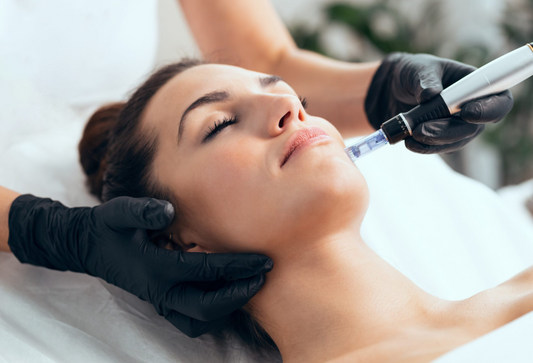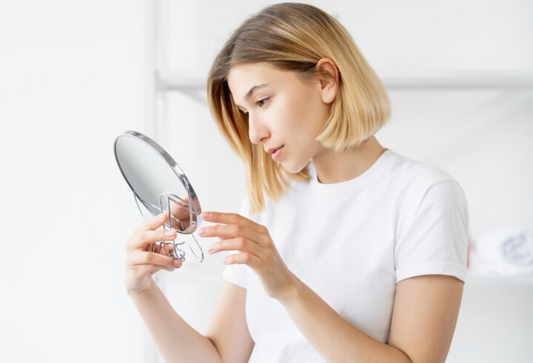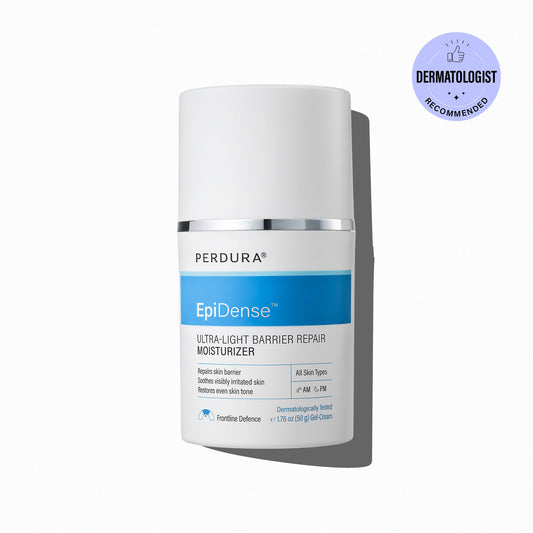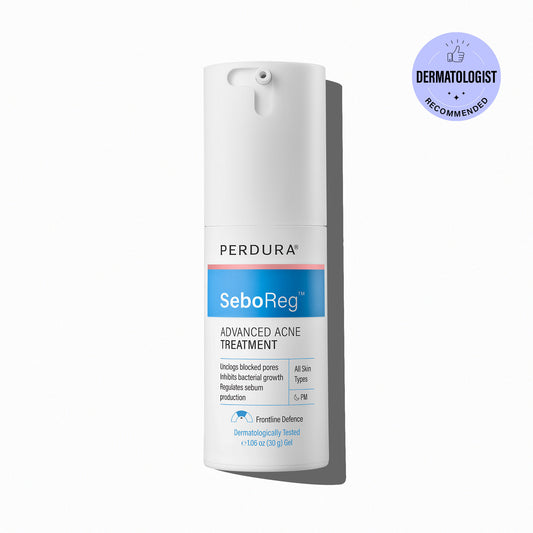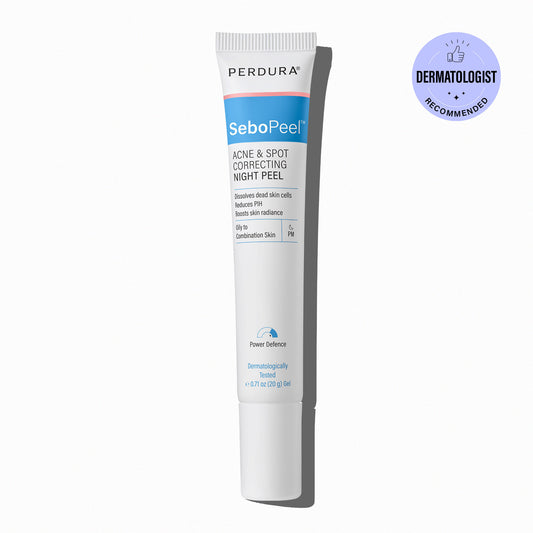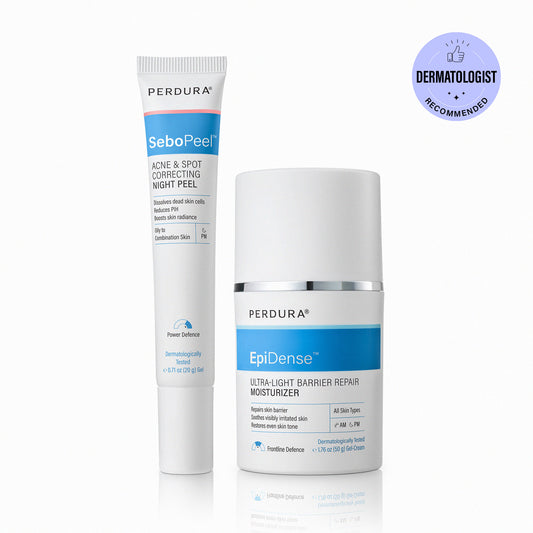Introduction
We all want clear, healthy skin, but figuring out which acne treatments would work best for our skin can feel overwhelming. One of the biggest concerns is choosing between prescription medication or over-the-counter (OTC) products.
Here's the good news: effective options are available for both ends of the spectrum. Let's break down the key differences between them to help you decide the best approach for your skin condition.
Curious about what your breakouts might be telling you? Dive deeper into our comprehensive guide on what pimples in different areas mean—Read more about Acne 101 here!
OTC Treatments: A First Line of Defense
Over-the-counter products are readily available at chemists or drugstores and are often a good starting point for mild to moderate acne. They typically contain ingredients that work together to improve skin health.

OTC acne products are generally divided into 4 types:
- Cleansers: eg: Salicylic acid face wash
- Leave-on Products: eg Adapalene gel (a topical retinoid)
- Mechanical Treatments: like exfoliating brushes or microfiber cloths
- Essential Oils: tea tree oil
- Supplements: eg Vitamin A or B complex or Zinc tablets
Many OTC products contain a combination of ingredients that work well to deal with acne. A few are given below.
| Mechanism of Action | Molecules |
| Exfoliation and Unclogging Pores | Salicylic Acid (BHA), Glycolic Acid (AHA), Mandelic Acid (AHA), Lactic Acid (AHA) |
| Anti-Inflammatory and Antibacterial | Benzoyl Peroxide, Tea Tree Oil, Azelaic Acid, Zinc PCA |
| Hydration and Moisturizing | Hyaluronic Acid, Sodium PCA, Ceramides, Phytosphingosine, Panthenol (Provitamin B5) |
| Regulates Oil Production and Reduces Redness | Niacinamide, Zinc PCA |
| Soothing and Calming | Bisabolol, Panthenol (Provitamin B5), Niacinamide |
| Promotes Skin Barrier Health | Ceramides, Phytosphingosine, Niacinamide |
| Cell Turnover and Anti-Aging | Bakuchiol |
| Promotes Hyaluronic Acid Production | N-Acetyl Glucosamine |
AHAs (Alpha Hydroxy Acids) are water-soluble acids that work on the surface of the skin to exfoliate dead skin cells, improving texture and revealing brighter, fresher skin, while BHAs (Beta Hydroxy Acids) are oil-soluble, penetrate deeper into the pores to remove dead skin cells and excess sebum, making them particularly effective for oily and acne-prone skin.
OTC products are a significant first step because they're:
- Accessible: You can grab them without a visit to the dermatologist.
- Affordable: They're generally less expensive than prescription medications.
- Gentle: They're a good option for those with sensitive skin.
However, there are some limitations to consider:
- Strength: OTC products typically contain lower concentrations of active ingredients than prescription medications. This might mean slower results for stubborn or severe acne.
- Trial and Error: Finding the right OTC product can involve some trial and error to see what works best for your skin
Looking for effective solutions to combat your acne concerns? We've explored a variety of powerful ingredients commonly found in OTC acne treatments. But did you know we offer a range of products formulated with these very ingredients? Discover Perdura!
Prescription Powerhouses: Tailored Treatments for Tough Acne
For moderate to severe acne, or when OTC options haven't delivered the desired results, prescription medications might be the way to go. Here's what you can expect:
- Stronger formulas: Prescription medications contain higher concentrations of active ingredients, making them more effective for tackling stubborn breakouts.
- A wider range of options: Dermatologists have access to a wider range of medications, including:
- Personalised approach: Dermatologists can tailor your treatment plan to your specific type and severity of acne.
Here are the most common prescription drugs used for acne prone skin:

Topical Retinoids
Examples: Tretinoin or Adapalene
Topical retinoids work by accelerating the rate of skin cell turnover, which helps prevent the formation of new acne lesions and promotes faster healing of existing pimples. They also help in reducing the appearance of fine lines and pigmentation by promoting collagen production.
Possible Side Effects:
- Initial purging: an increase in acne lesions at the start of treatment.
- Dryness and irritation: common side effects due to increased skin cell turnover.
- Sensitivity to sunlight: retinoids can make the skin more sensitive to uv radiation, so you have to use sunscreen with every application.
Antibiotics
Examples:
- Topical Antibiotics: Such as clindamycin and erythromycin, which are applied directly to the skin to reduce bacteria and inflammation.
- Oral Antibiotics: Like doxycycline and minocycline, which are used for more severe or widespread acne.
Antibiotics work by targeting and reducing the bacteria that contribute to acne (primarily Propionibacterium acnes). They also have anti-inflammatory properties that help to reduce redness and swelling associated with acne lesions.
- Antibiotic Resistance: Prolonged use can lead to resistance, making bacteria harder to treat.
- Nausea, vomiting and acidity: Especially with oral antibiotics.
- Photosensitivity: Increased sensitivity to sunlight, which can lead to sunburn.
Hormonal Therapies
Hormonal therapies work by regulating the hormones that can cause acne, particularly in women. Androgens, such as testosterone, can stimulate excess sebum production and clogged pores. By modulating these hormones, these therapies can effectively reduce or eliminate breakouts.
Struggling with acne-prone skin? Discover the link between your hormones and repeated breakouts in our detailed blog. Learn more about hormonal acne now!
Examples:
- Oral Contraceptives: Pills containing estrogen and progesterone that help regulate hormone levels.
- Spironolactone: This helps reduce the production of natural oils or sebum on the skin and the occurrence of acne.
Possible Side Effects:
- Hormonal fluctuations can affect mood.
- Some users experience changes in weight.
While prescription medications offer a greater chance of success for challenging acne, there are some additional considerations:
- Cost: Prescription medications can be more expensive than OTC options and may not be fully covered by insurance.
- Side effects: Some medications can cause side effects such as dryness, redness, and sun sensitivity.
- Doctor's visit required: You must see a dermatologist for a diagnosis and prescription.
The Best Treatment for You
Ultimately, the best acne treatment depends on the severity and type of your acne, as well as your skin sensitivity and preferences. Here are some tips:

- Start with OTC options: OTC products might be a good place to begin if you have mild acne. Be patient – it can take several weeks to see results.
- Consult a dermatologist: If you have moderate to severe acne, are struggling to find the right OTC product, or experience significant side effects, don't hesitate to make an appointment with a dermatologist. They can assess your specific situation and create a personalised treatment plan.
- Be patient and consistent: Consistent use is key, whether using OTC or prescription treatments. It can take time to see significant improvement.
Conclusion
Choosing the right acne treatment, whether OTC or prescription, begins with understanding the ingredients in your skincare products. So, take the time to learn, and you'll be well on your way to healthier skin.
Key Takeaways
- OTC products are generally suitable for mild to moderate acne and are more accessible and affordable, while prescription medications are tailored for moderate to severe cases and offer stronger, faster results.
- Understanding the active ingredients in acne treatments, such as salicylic acid, benzoyl peroxide, and retinoids, is crucial in choosing the right product for your skin type.
- Consulting a dermatologist is recommended for persistent, moderate to severe acne or if you are uncertain which products to use, ensuring a treatment plan that is tailored to your specific needs.
- Whether using OTC or prescription treatments, consistency and patience are key, as significant improvements can take time.
- Both OTC and prescription acne treatments can have side effects, such as dryness and increased sensitivity to sunlight, which should be managed with appropriate skincare products and routines.

